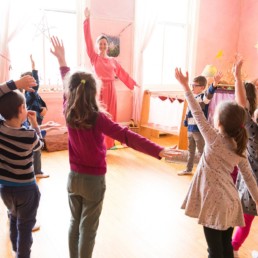
On Friday, March 2nd, the Susquehanna Waldorf School hosted their annual Spring Eurythmy assembly. With Eurythmy Teacher Katie O’Brien’s bright eyes and graceful, sweeping gestures, each grade took the center of the gym in turn, painting an artistic picture for the audience of how human beings can work and move together, and make their bodies sing.
To an onlooker who didn’t know, one might find it difficult to distinguish eurythmy from a form of dance. It was, in fact, a young dancer who came to Rudolf Steiner, the founder of Waldorf education, and said, “I want to bring something new to movement. Something is missing.” This sparked the inauguration of eurythmy, an entirely new form of expressive movement art unique to Waldorf education. By definition, eurythmy is “a system of harmonious body movement to the rhythm of spoken words.” In dance, it is the physical form and exact body position that are paramount; eurythmy, in contrast, is about bringing words and sounds into formation, using the human body in motion as its instrument. Sound and gesture are united as the body becomes the vowels, consonants, and music being played. It is an art that makes a nod to the heart and the inner life, acknowledging that what we hear is not just audible, but also harnesses an emotional and physical hold.
Opening the March 2nd assembly, the younger students trickled down from the bleachers into a circular formation as O’Brien recited a poem, then knitted the circle into an increasingly intricate spiral as the pace of the verse increased. Movements flowed seamlessly with the consonants and vowels, keeping pace with the quick alliteration of lines like “bright are the sparks; sparks kindle light.” As the assembly continued, the classes expressed a progression towards more complex coordination and greater sensitivity to the space between their peers, forming shapes with their bodies that seemed invisibly tethered to the sounds and the surroundings.
Year by year, students of eurythmy at the Susquehanna Waldorf School are guided through exercises that are aligned developmentally to nurture intelligent hands and feet and, in turn, a thoughtful, thinking heart. It is a holistic approach to movement. Every consonant and vowel in eurythmy has its own sound and archetypal gesture; “b,” for instance, becomes alive in the verse as the “bear,” hands stretching the air apart like opening the bellows of an invisible accordion. “The gift of eurythmy,” says O’Brien, “is that the child can learn to experience themselves gracefully, maintain space thoughtfully, and move harmoniously with others.” When a student new to eurythmy, for instance, is instructed to walk backwards, they instinctively feel the need to look over their shoulder. “Gradually, they stop looking: they learn to trust themselves and the world they can’t see,” notes O’Brien.
This individual mastery that eurythmy cultivates also stimulates a deep sensitivity to others. In one Waldorf school, a basketball coach, impressed by the harmonious movement of the opposing team, asked the Waldorf coach how he was able to foster such orchestrated movement in his players. On overhearing this question, a teammate interjected that is was a result of their eurythmy training.
As the Spring Assembly came to a close, parents were encouraged to stay for a brief eurythmy lesson. O’Brien asked the small group to first form a circle; after forming something reminiscent of a squiggly star, then a lopsided oval, the parents were at last corralled into something more concentric. “Waldorf students are capable of making circles very quickly and accurately,” O’Brien commented with a smile. This spatial awareness is also seen in Waldorf geometry classes, where students are able to draw circles freehand that look like they were crafted with the precision of a compass tool.
“Eurythmy teaches you to find your center,” says O’Brien. Through the concentration, self-discipline, and sense of beauty that eurythmy instills, students at the Susquehanna Waldorf School are ultimately inspired by a shared intention to live harmoniously, within themselves and with others.
